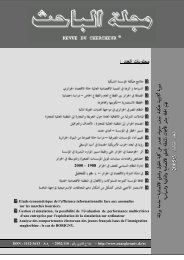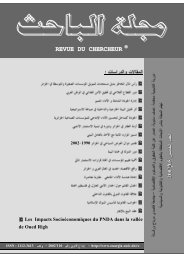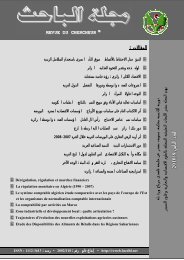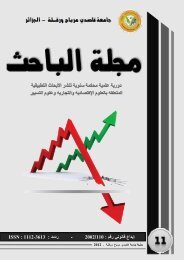El-BAHITH REVIEW Number 09 _ University Of Ouargla Algeria
Annual refereed journal of applied reserch in economic, commercial and managment sciences
Annual refereed journal of applied reserch in economic, commercial and managment sciences
Create successful ePaper yourself
Turn your PDF publications into a flip-book with our unique Google optimized e-Paper software.
_______________________________________________________________________________________________________________________________________<br />
مجلة الباحث – عدد 2011 / <strong>09</strong><br />
Malaysia, Philippines, Singapore, and Taiwan, over different periods of time. His results suggest<br />
that “there exists evidence against the hypothesis that savings respond positively to the rate of<br />
interest in LDCs”.<br />
Mejía and Ortega (1998) examined the determinants of private savings in Colombia with a<br />
view to explain the decline of the private saving rate in the 1990s, the consumption boom,<br />
corporate behavior, and tax increase. Their results revealed “that the recent decline of private<br />
saving was not associated with the significant increases in the share of private consumption in<br />
GNP. The empirical evidence indicated that permanent income is the only variable capturing the<br />
"euphoria" factor attributed to the structural reforms undertaken during the 1990s and that total<br />
private saving is not determined by corporate behavior. Furthermore, tax increase can not entirely<br />
explain the recent collapse of the private saving rate”.<br />
Brooks (2003) used a multi regional over-lapping generation model with perfect capital<br />
mobility to simulate the general equilibrium effects of projected population trends on international<br />
capital flows. He found that the “retirement saving by aging baby boomers will raise the supply of<br />
capital substantially above investment in both European union and North America… Africa will<br />
remain dependent on foreign capital for the foreseeable future because of continued high<br />
population growth”.<br />
Using Granger-Causality test, Emmanuel and Ahmad (2001) examined the causality between<br />
economic growth and the growth rate of domestic savings for Congo, Côte d'Iviore, Ghana,<br />
Nigeria, Kenya, South Africa, and Zambia. The empirical results indicate that for Ghana, Kenya,<br />
Nigeria and Zambia, economic growth Granger causes growth of domestic saving. This result is<br />
consistent with the results found by Abdalla (2002) for the case of Sudan (1971-1994), Kher Allah<br />
(2002) for the case of Tanzania (1973-1994) and Awad Allah (2002) for the case of Kenya (1972-<br />
1995). For the case of Congo, the result indicated that growth of domestic savings Granger causes<br />
economic growth. For the case of South Africa and Côte d'Iviore, the results revealed the<br />
existence of two way causality. This is consistent with the results reported by Omer (2002) for the<br />
case of Nigeria (1973-1994), and Abu Baker (2002) for the case of South Africa (1973-1995).<br />
As noted earlier, the purpose of this paper is to examine from an empirical point of view the<br />
determinants of savings for a set of African countries (as listed in Table A.1 of the appendices). For<br />
this purpose, the next section outlines the empirical model and the methodology adopted in the<br />
analysis.<br />
3. The Empirical Model and Methodology :<br />
-25-















